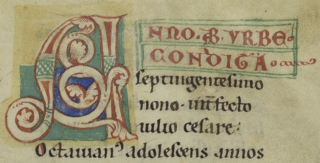Related Research Articles

The terms anno Domini (AD) and before Christ (BC) are used when designating years in the Julian and Gregorian calendars. The term anno Domini is Medieval Latin and means "in the year of the Lord" but is often presented using "our Lord" instead of "the Lord", taken from the full original phrase "anno Domini nostri Jesu Christi", which translates to "in the year of our Lord Jesus Christ". The form "BC" is specific to English, and equivalent abbreviations are used in other languages: the Latin form, rarely used in English, is Ante Christum natum (ACN) or Ante Christum (AC).

Ab urbe condita, or anno urbis conditae, abbreviated as AUC or AVC, expresses a date in years since 753 BC, the traditional founding of Rome. It is an expression used in antiquity and by classical historians to refer to a given year in Ancient Rome. In reference to the traditional year of the foundation of Rome, the year 1 BC would be written AUC 753, whereas AD 1 would be AUC 754. The foundation of the Roman Empire in 27 BC would be AUC 727. The current year AD 2024 would be AUC 2777.
Common Era (CE) and Before the Common Era (BCE) are year notations for the Gregorian calendar, the world's most widely used calendar era. Common Era and Before the Common Era are alternatives to the original Anno Domini (AD) and Before Christ (BC) notations used for the same calendar era. The two notation systems are numerically equivalent: "2024 CE" and "AD 2024" each describe the current year; "400 BCE" and "400 BC" are the same year.
An era is a span of time defined for the purposes of chronology or historiography, as in the regnal eras in the history of a given monarchy, a calendar era used for a given calendar, or the geological eras defined for the history of Earth.
The Julian calendar is a solar calendar of 365 days in every year with an additional leap day every fourth year. The Julian calendar is still used as a religious calendar in parts of the Eastern Orthodox Church and in parts of Oriental Orthodoxy as well as by the Amazigh people.

A year is the time taken for astronomical objects to complete one orbit. For example, a year on Earth is the time taken for Earth to revolve around the Sun. Generally, a year is taken to mean a calendar year, but the word is also used for periods loosely associated with the calendar or astronomical year, such as the seasonal year, the fiscal year, the academic year, etc. The term can also be used in reference to any long period or cycle, such as the Great Year.
AD 1 (I) or 1 CE was a common year starting on Saturday or Sunday, a common year starting on Saturday by the proleptic Julian calendar, and a common year starting on Monday by the proleptic Gregorian calendar. It is the epoch year for the Anno Domini (AD) Christian calendar era, and the 1st year of the 1st century and 1st millennium of the Christian and Common Era (CE).
The proleptic Julian calendar is produced by extending the Julian calendar backwards to dates preceding AD 8 when the quadrennial leap year stabilized. The leap years that were actually observed between the implementation of the Julian calendar in 45 BC and AD 8 were erratic.
In chronology and periodization, an epoch or reference epoch is an instant in time chosen as the origin of a particular calendar era. The "epoch" serves as a reference point from which time is measured.
The 10th millennium BC spanned the years 10,000 BC to 9001 BC. It marks the beginning of the transition from the Palaeolithic to the Neolithic via the interim Mesolithic and Epipaleolithic periods, which together form the first part of the Holocene epoch that is generally believed to have begun c. 9700 BC and is the current geological epoch. It is impossible to precisely date events that happened around the time of this millennium, and all dates mentioned here are estimates mostly based on geological analysis, anthropological analysis, and radiometric dating.

Chronology is the science of arranging events in their order of occurrence in time. Consider, for example, the use of a timeline or sequence of events. It is also "the determination of the actual temporal sequence of past events".
A calendar era is the period of time elapsed since one epoch of a calendar and, if it exists, before the next one. For example, it is the year 2024 as per the Gregorian calendar, which numbers its years in the Western Christian era.
Before Present (BP) years, also known as "time before present" or "years before present (YBP)", is a time scale used mainly in archaeology, geology, and other scientific disciplines to specify when events occurred relative to the origin of practical radiocarbon dating in the 1950s. Because the "present" time changes, standard practice is to use 1 January 1950 as the commencement date (epoch) of the age scale. The abbreviation "BP" has been interpreted retrospectively as "Before Physics", which refers to the time before nuclear weapons testing artificially altered the proportion of the carbon isotopes in the atmosphere, which scientists must account for.
The Era of the Martyrs, also known as the Diocletian era, is a method of numbering years based on the reign of Roman Emperor Diocletian who instigated the last major persecution against Christians in the Empire. It was used by the Church of Alexandria beginning in the 4th century AD and it has been used by the Coptic Orthodox Church of Alexandria from the 5th century until the present. This era was used to number the year in Easter tables produced by the Church of Alexandria.

Anno Mundi, abbreviated as AM or A.M., or Year After Creation, is a calendar era based on the biblical accounts of the creation of the world and subsequent history. Two such calendar eras have seen notable use historically:

The Shaka era is a historical Hindu calendar era, the epoch of which corresponds to Julian year 78.

Anno Lucis is a dating system used in Masonic ceremonial or commemorative proceedings, which is equivalent to the Gregorian year plus 4000. It is similar to Anno Mundi.
A year zero does not exist in the Anno Domini (AD) calendar year system commonly used to number years in the Gregorian calendar ; in this system, the year 1 BC is followed directly by year AD 1. However, there is a year zero in both the astronomical year numbering system, and the ISO 8601:2004 system, the interchange standard for all calendar numbering systems. There is also a year zero in most Buddhist and Hindu calendars.
The Spanish era, sometimes called the era of Caesar, was a calendar era commonly used in the states of the Iberian Peninsula from the 5th century until the 15th, when it was phased out in favour of the Anno Domini (AD) system. The epoch of the Spanish era was 1 January 38 BC. To convert an Anno Domini date to the corresponding year in the Spanish era, add 38 to the Anno Domini year, such that Era 941 would be equivalent to AD 903. A date given in the Spanish era always uses the word era followed by a feminine ordinal number. This contrasts with the AD system that uses the masculine anno (year): i.e., era millesima octava versus anno millesimo octavo.
The Meghalayan age is the name given in 2018, by the International Commission on Stratigraphy, to the current age or latest geologic age – or uppermost stage of the Quaternary. It is also the upper, or latest, of three subdivisions of the Holocene epoch or series. This way of breaking down time is based only on geology; for example, it is unrelated to the three-age system of historical periods into which human development is sometimes divided.
References
- 1 2 3 Emiliani, Cesare (1993). "Correspondence – calendar reform". Nature. 366 (6457): 716. Bibcode:1993Natur.366..716E. doi: 10.1038/366716b0 .
- 1 2 Naudin, Claude (2001). De temps en temps: Histoires de calendrier[From time to time: Calendar stories]. Le Grand Livre du Mois. ISBN 2-7028-4735-8.
- 1 2 Hope, E.R. (1963). "The arithmetical reform of the calendar, Part I". Journal of the Royal Astronomical Society of Canada. 57 (1): 14–23. Bibcode:1963JRASC..57...14H.
- ↑ Rahner, Karl (2004). Encyclopedia of theology: a concise Sacramentum mundi. Continuum. p. 732. ISBN 978-0-86012-006-3. Archived from the original on July 27, 2020. Retrieved October 8, 2020.
- 1 2 Emiliani, Cesare (1994). "Calendar reform for the year 2000". Eos. 75 (19): 218. Bibcode:1994EOSTr..75..218E. doi:10.1029/94EO00895.
- 1 2 Walker, Mike; Jonsen, Sigfus; Rasmussen, Sune Olander; Popp, Trevor; Steffensen, Jørgen-Peder; Gibbard, Phil; Hoek, Wim; Lowe, John; Andrews, John; Björck, Svante; Cwynar, Les C.; Hughen, Konrad; Kershaw, Peter; Kromer, Bernd; Litt, Thomas; Lowe, David J.; Nakagawa, Takeshi; Newnham, Rewi; Schwander, Jacob (2009). "Formal definition and dating of the GSSP (Global Stratotype Section and Point) for the base of the Holocene using the Greenland NGRIP ice core, and selected auxiliary records" (PDF). Journal of Quaternary Science. 24 (1): 3–17. Bibcode:2009JQS....24....3W. doi: 10.1002/jqs.1227 . Archived (PDF) from the original on 2013-11-04.
- ↑ Nastevičs, Uģis (2022). "Latvian Dievturība: A Study of Rituals, Their Sacred Space and Texts". Dievturu Vēstnesis. 43 (3): 2467–2481. ISSN 2661-5088.
- ↑ Nastevičs, Uģis (2022). Latviešu dievturība un japāņu šintō. Rituāli, to sakrālā telpa un teksti salīdzinošā aspektā. Puzuri. ISBN 9789934906725.
- ↑ Brastiņš, Ernests (1934). "Latviskais laiks". Labietis. 5: 72–73. ISSN 0456-9571.
- 1 2 3 Dershowitz, Nachum; Reingold, Edward M. (2008). Calendrical Calculations (3rd ed.). Cambridge University Press. ISBN 978-0-521-70238-6.
- ↑ See: Matchett, Freda, "The Puranas", p 139 and Yano, Michio, "Calendar, astrology and astronomy" in Flood, Gavin, ed. (2003). Blackwell companion to Hinduism. Blackwell Publishing. ISBN 978-0-631-21535-6.
- ↑ "ICS chart containing the Quaternary and Cambrian GSSPs and new stages (v 2018/07) is now released!". Archived from the original on February 19, 2020. Retrieved February 6, 2019.
- ↑ Conners, Deanna (September 18, 2018). "Welcome to the Meghalayan age". Archived from the original on February 2, 2019. Retrieved February 6, 2019.
- ↑ Aisha El-Awady (2002-06-11). "Ramadan and the Lunar Calendar". Islamonline.net. Archived from the original on 2006-12-14. Retrieved 2006-12-16.
- ↑ Hakim Muhammad Said (1981). "The History of the Islamic Calendar in the Light of the Hijra". Ahlul Bayt Digital Islamic Library Project . Archived from the original on 2011-06-10. Retrieved 2006-12-16.
- ↑ Hy-Sang Lee (2001). North Korea: A Strange Socialist Fortress. Greenwood Publishing Group. p. 220. ISBN 978-0-275-96917-2.
- ↑ Endymion Wilkinson (2000). Chinese History: A Manual. Harvard Univ Asia Center. pp. 184–185. ISBN 978-0-674-00249-4.
- ↑ Currie Lloyd A (2004). "The Remarkable Metrological History of Radiocarbon Dating [II]" (PDF). Journal of Research of the National Institute of Standards and Technology. 109 (2): 185–217. doi:10.6028/jres.109.013. PMC 4853109 . PMID 27366605. Archived from the original (PDF) on 2010-12-06. Retrieved 2018-06-24.
- ↑ "The Open Group Base Specifications Issue 7, Rationale, section 4.16 Seconds Since the Epoch". The OpenGroup. 2018. Archived from the original on 2017-11-15. Retrieved 2018-06-24.

